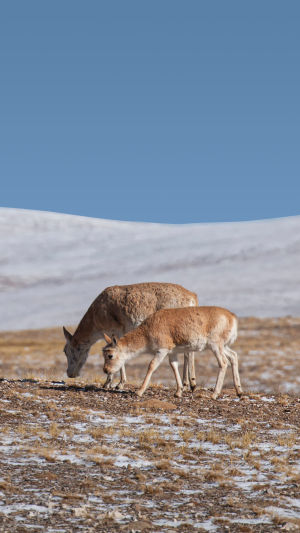Tibetan antelopes are known as "plateau elves" because they inhabit the plateau environment at an altitude of 4,600 to 6,000 meters. Tibetan antelope is an extremely important part of the natural ecology of the plateau, and it is particularly important for maintaining ecological balance.
Tibetan antelopes mostly live on the Qinghai-Tibet Plateau, with a small amount in India. Tibetan antelope is a social creature, only males have horns, and the horns are about 60 cm long. Because the two horns are very symmetrical, from the side, it seems that there is only one horn, so it is also called "unicorn".
Tibetan antelope is a typical representative of plateau animals. The body color is mainly light brown, and the hair on the whole body is very thick and dense. The area where Tibetan antelopes live spans 1,600 kilometers. The migration of Tibetan antelopes is currently one of the most spectacular migrations of three ungulates in the world.
Tibetan antelopes especially like flat grassy beaches near water sources. Tibetan antelopes are generally timid, and usually hide in a cave, or dig a small shallow pit in a relatively flat place, lie down in the whole body, and only expose the head, which can not only avoid the wind and sand, but also detect danger at any time.
The vegetation in the plateau area is relatively sparse. In addition, the temperature in these areas is lower, and many lands are covered by snow for more than 6 months. In such a harsh natural environment, in order to find satisfactory food and resist the cold, Tibetan antelopes form a habit of migrating in groups, and their bodies grow with a layer of down that provides excellent warmth.
The activities of Tibetan antelopes are very complicated. Some Tibetan antelopes live in one place for a long time, and some have the habit of migration. Female and male Tibetan antelope also have different activity patterns. Young male Tibetan antelopes will leave the colony and join other young or adult male Tibetan antelopes until they eventually form a mixed colony.
Adult female Tibetan antelopes and their female offspring migrate 300 kilometers each year from the winter mating site to the summer lambing site. Female Tibetan antelopes have to go to Hoh Xil to give birth to their offspring, probably because of the environmental advantages of Hoh Xil. With abundant aquatic plants and few natural enemies, a relatively safe environment is conducive to the production and growth of Tibetan antelope.
Tibetan antelopes mainly forage in the early morning and evening, but in winter and spring when food conditions are relatively poor, their foraging time is extended, so they can often be seen moving around during the day. In summer and autumn when food is abundant, they rest by the lake and river bank at noon.
Due to people's demand for cashmere, Tibetan antelopes have suffered a lot of cruel poaching, resulting in a sharp decline in their numbers. In addition, due to the serious interference of poaching activities, the original activity rules of Tibetan antelope are disturbed, which has a serious impact on the reproduction of the population.
Fortunately, the living conditions of Tibetan antelopes have attracted global attention, and activities to protect Tibetan antelopes have been fully launched. Due to the establishment of the reserve, the number of Tibetan antelopes has gradually increased, and the living environment has gradually improved. While we enjoy modern life, it is best to minimize the impact on nature.
Humans have no reason to deprive other animals of their right to live for their own sake. Maybe what we are doing now is not perfect, but this blue planet will definitely be a harmonious home for human beings and other animals in the future.





